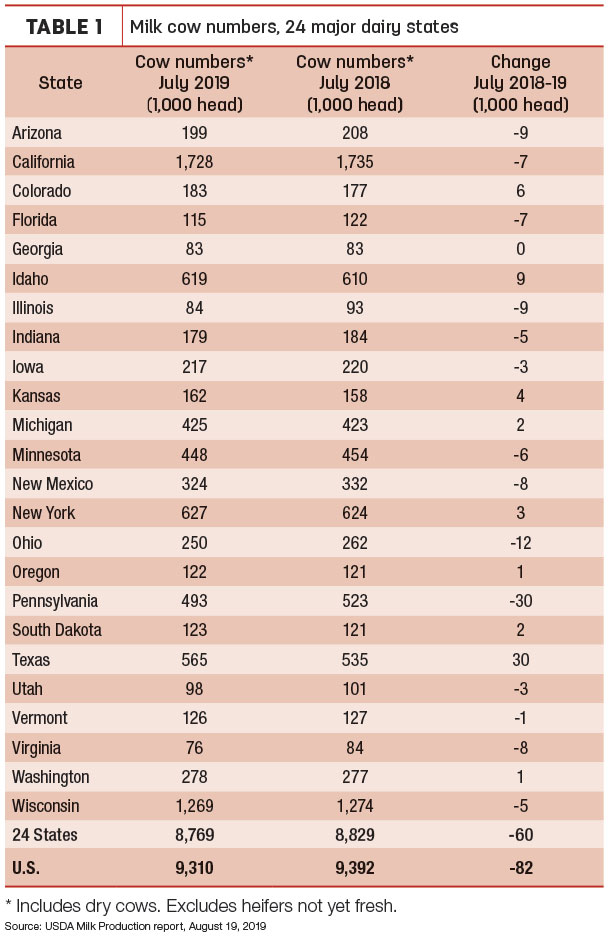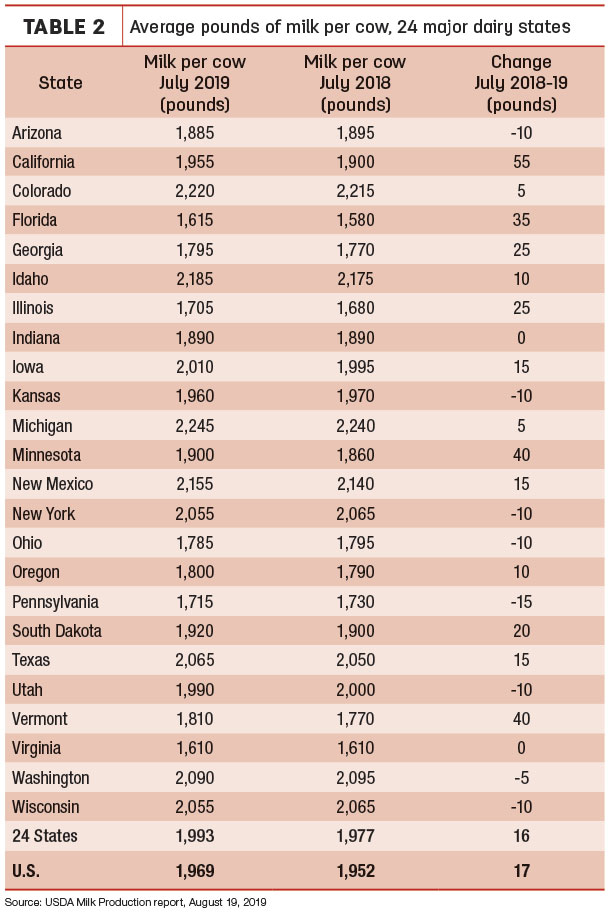July 2018-19 recap at a glance
The 2019 storyline continues: Heavy cow culling and slow growth in milk output per cow held down overall July milk production growth. Reviewing the USDA estimates for July 2019 compared to July 2018:
- U.S. milk production: 18.33 billion pounds, unchanged
- U.S. cow numbers: 9.31 million, down 82,000 head
- U.S. average milk per cow per month: 1,969 pounds, up 17 pounds
- 24-state milk production: 17.48 billion pounds, up 0.1%
- 24-state cow numbers: 8.769 million, down 60,000 head
- 24-state average milk per cow per month: 1,993 pounds, up 16 pounds
Source: USDA Milk Production report, Aug. 19, 2019
Monthly year-over-year output growth has now been under 1% for 10 consecutive months. Previous periods when milk production growth was less than 1% was in seven of eight months to end 2014 and nine of 11 months from June 2011-April 2012.
Cow numbers lowest since January 2016
July U.S. dairy cow numbers declined 9,000 head from June to 9.31 million head, the smallest U.S. dairy herd since January 2016. Among the 24 major dairy states, July 2019 cow numbers were down 8,000 from June (Table 1).

U.S. dairy farmers continue to move dairy cull cows to slaughter at a high rate. Federally inspected milk cow slaughter was estimated at 1.868 million through July 27, 2019, about 78,800 head more than a similar date a year earlier, according to the USDA.
Nine states increased cow numbers compared to July 2018, with the largest jumps in Texas (+30,000 head) and Idaho (+9,000). The decline in Pennsylvania (-30,000) completely offset the increase in Texas. Other states seeing substantial declines were Ohio (-12,000), with California, Florida, New Mexico, Virginia, Arizona and Illinois each down 7,000 to 9,000 head. Iowa, Minnesota and Wisconsin were down a combined 14,000 head.
Cows in 10 states yielded steady to lower milk output per cow in July compared to the same month a year earlier (Table 2). Biggest gains were in California (+55 pounds) and Minnesota and Vermont (both +40 pounds per cow). Michigan led all states in milk production per cow for the month.

Among all major states, California led in terms of milk volume growth in July 2019, up 83 million pounds (2.5%) from a year earlier. On a percentage basis, Colorado and Texas saw increases of nearly 6% each, for a combined increase of 87 million pounds.
Pennsylvania production was down 58 million pounds (-6.5%), while Wisconsin, Arizona and Ohio saw output decline by 25 million to 28 million pounds from July 2018.
Cropp shares outlook
Bob Cropp, dairy economics professor emeritus with the University of Wisconsin – Madison, found optimism in the continued flat-to-negative milk production. He cites several reasons for his belief milk prices could end 2019 stronger than current futures prices indicate.
Among them, domestic demand has been good enough to help pull down dairy product inventories, and prices could be pressured higher as holiday buying picks up. The start of school means more milk will be pulled into the fluid market, leaving less milk for dairy products.
Cropp does forecast some milk price softening in early 2020, but suggests several factors will limit milk production growth: Dairy cull cow slaughter remains high, and latest estimates indicate the number of dairy replacement heifers are the lowest since 2009. Supplies of high-quality hay are tight, and feed prices are higher.
Cropp sees a small increase in the August Class III price, based on stronger cheese and whey prices, and a small decrease in the Class IV price due to slightly weaker butter and nonfat dry milk prices. Federal Milk Marketing Order August price will be announced Sept. 5.
Read also: Milk price outlook improves on further production cuts. ![]()

-
Dave Natzke
- Editor
- Progressive Dairy
- Email Dave Natzke






